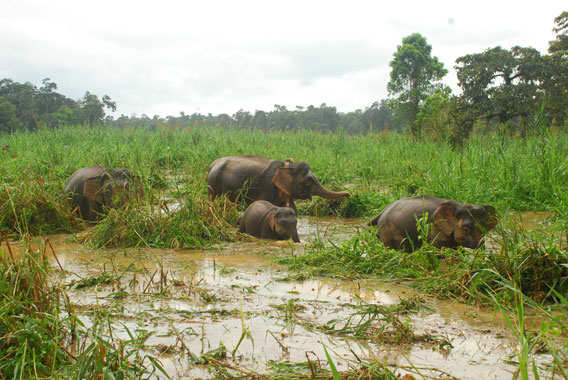 |
| Borneo elephants in their habitat. Photo: Benoit Goosens |
By using the advanced technology of DNA sequencing methodologies to collaborate with Malaysia Sabah Wildlife Department, Rachel O'Neill Laboratories at the University of Connecticut and a private company called Floragenex, researchers led by Lounes Chikhi been able to identify genetic markers of Borneo elephants are endangered.
A blood sample testing of endangered species in very little has been demonstrated that the Borneo elephants have very low genetic variability, which may affect their ability to survive in their habitats are threatened.
For researchers, studying the variability of endangered species has become an increasingly important requirement for conservation and monitoring in the future. So far, these efforts are constrained from the difficulty of observing and taking genetic samples from endangered species are very difficult to find. This limiting factor in the end result in limited genetic diversity of endangered species information that can be learned.
Until now, the process to find a genetic marker that is time consuming and requires no small cost. This hitch also makes the process of collecting genetic data from species threatened with extinction is difficult to implement.
However, recently, a group of researchers led by Lounes Chikhi, from the Instituto Gulbenkian de Ciencia (IGC) and the CNRS of Toulouse, France, has managed to change the difficulty when looking for the genetic diversity of Borneo elephant. The results of the study the researchers, such as those recently published in the journal PLoS ONE, not only contributing to the Borneo elephant conservation efforts, but also opened up the discourse to the conservation of other endangered species.
Reeta Sharma, a member of the research team from Chikhis Lounes who is doing his Post-doctoral education, for the first time succeeded in identifying the character of the genome, or genetic marker-, - of the Borneo elephant DNA sequences. The researchers used two different DNA pengurut technology that works fast. Previously, this technology has been used for various laboratory species such as fruit flies and mice, but the difference is now used to study endangered species.
Until now, to find out whether this species still contain significant genetic diversity, it is necessary to look at the broader genomic region using classical genetic methodologies, or the use of genetic markers that have been made for others at various levels of success standard. However, this approach is not sustainable for endangered species, whose numbers continue to shrink over time. The only studies that have been conducted on Borneo elephant is using genetic markers with other Asian elephants and barely found genetic diversity.
DNA analysis conducted by researchers generated from blood samples collected from seven elephants from Borneo Lok Kawi Wildlife Park (Sabah, Malaysia) and from an elephant named Chendra, which is the star of the Oregon Zoo in Portland, USA.
The research team believes that this method of DNA sequencing or sequencing can be used for other genetic typing of biological samples, such as hair or dirt, and is easier to get it from the wildlife, although blood or tissue samples are still needed to identify markers in the first stage.
Reeta Sharma, one of the authors of the study said: "The methodology used to identify genetic markers for Borneo elephants may be used in future studies on the genetic variability of other species or populations at risk of extinction."
Borneo elephants
Borneo elephants (Elephas maximus borneensis) is a unique species, and is a sub-species of the Asian elephant, with differences in morphology and behavior. In general, they are smaller or dwarf in comparison of other elephants, the tusks are straight and long tail. Currently Borneo elephants is estimated at only 2,000 left in the wild, and only in the northern part of the island of Borneo. Is still a mystery how they could evolve into a very different shape this time and why they were separated from the distribution of elephants.
The origin of Borneo elephants which have long caused controversy discussed. The only study done on the basis of genetic data have concluded that they had been present in Borneo for more than 300,000 years ago. This theory does not satisfy all of the researchers due to the lack of fossil elephants in Borneo to support it. Another theory is that the Javanese sultan sent Javan elephants as gifts to the Sultan of Sulu, who will introduce them to Borneo.
Borneo elephants live in an environment where their natural habitat is lost quickly, because oil palm plantations and their populations are isolated from each other. Having access to the variable genetic markers will be important to identify an isolated population in the context of their population monitoring purposes in the future.
Despite that they are one of the main species a priority in elephant conservation in Asia, up to now there are only very limited tools to study the genetic variability of this species, and none of them created specifically to study these creatures.
Lounes Chikhi suggested: "The new genetic Bookmarks we found it also allows us to unravel the mystery of the origins of elephants in Borneo, and may reconstruct part of their demographic history. It's very exciting. "
Sources: :http://www.mongabay.co.id/2012/11/23/penelitian-membongkar-misteri-genetika-gajah-kalimantan/#ixzz2DP9n7iaH
1 komentar:
wah ternyata di Borneo Ada gajah juga. Aku kira cuma dongeng aja.
Posting Komentar